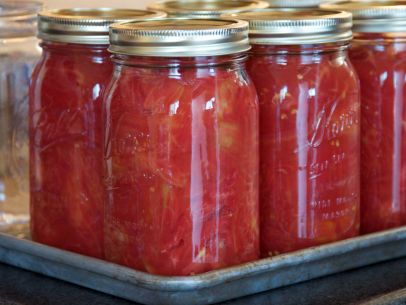It’s hard to admit to oneself and harder still to others, that you have let things slip. In the 21st century world of technologies that can keep you abreast of anything it’s strangely comforting to know that nature has a way of slipping by you and your Fitbit and rolling unimpeded into early autumn.
Yes your best laid garden (like mine) is full of weeds, flowering herbs and drying vines. Yes, the zucchini in my garden never stood a chance against the squirrels. Blackberries destined for a luscious cobbler have vanished as well or dried on the bush, bitter and charred by the heat.
School kicks in this week signaling a “faux summer” when we try our best to believe that still have plenty of the real summer left. For the gardens and the growers, the planners and the canners the clock is ticking loudly. The Sage Rabbit recently took delivery of 200 pounds of local organic tomatoes from a local farm bursting at the seams. Some will go directly into service, some to Crave this weekend, but the bulk of the delivery and others like it over the next few weeks will go to the freezer, the drying rack or a brine.
Tomatoes and peppers will be smoked and peeled, roasted or blanched to be used for soups, stews and chilies. Pesto will be pulsed and frozen, vegetable and chicken stock will be generated almost daily and broken down into blocks to be frozen and pulled when our soups return to cold weather richness. As much as we can we will be trying to catch the summer at its peak, before the vines get tired and the fruit starts to break down on the tree.
I can’t honestly say that any of this is planned. There is no red letter date on the calendar that I wake up to one August morning. I know of some families that still set aside some time late in the season with the express purpose of canning literally everything but that, unfortunately, is not my style.
My garden grows more slowly in certain areas and on a much larger scale that can be a farmer’s nightmare. What is certain though is that vegetables can be forgiving to a time strapped farmer. Another day on the vine won’t ruin that tomato, flowering herbs continue to grow and will still dry nicely, pesto can be made from the last of the basil and can often have a heftier flavor which stands up well to freezing. So if you are frantic about the closing windows of opportunity then take a deep breath and consider these few steps.
Drying herbs – I like to take the flowering herbs just after they have bloomed, the moisture content is lower without being desiccated and the chances of a successful drying start with the herbs moisture content. Small bunches with one layer on a cooling rack is best but not very romantic. If you choose to hang bunches of herbs in your kitchen do so in small batches, away from the stove (humidity) the dishwasher (more humidity) or on top of the fridge.
Unless you have an open rafter, stone floor Tuscan farm kitchen, its best to pick a dry well ventilated spot in the house, the breezeway perhaps in which to properly dry herbs. Once dry place them in zip lock bags. Any more exposure will result in dust and other particles settling on the bunch. Freezing herbs will darken most of them severely which will affect the flavor and alter our perception of the herb.
Freezing pesto – Do it if possible in the smallest amounts that you can. Purchase half pint containers with a good snap tight lid, don’t skimp! Make the pesto and fill the containers to just below the rim. Allow only a small amount of space to cut down on air left in the container which could lead to freezer burn. Place the containers in the fridge overnight which will let them settle and the oil come to the top.
This helps to seal the top and prevent browning from oxidation. After a night in the fridge, resnap the lids and place on a level shelf of the freezer until they are frozen. You can then move them to the back. Make sure they are dated.
Pickling cucumbers – I prefer “icebox pickles”, ones with a bite and a clarity of flavor typical of an uncooked cucumber. You will still need the Mason jars, cleaned and sanitized and some refrigerator space as these will not be placed in a pressure cooker. The choice of brine depends on the flavor profile of the pickle.
Like garlic? Add a bunch to water, apple cider vinegar, sugar, red chili flakes and kosher salt. Bring the brine to a simmer and taste a bit. Adjust the flavor and then let cool slightly. Slice the larger cucumbers so the brine can work quickly on the cut surface, if you have small pickling cucumbers you can leave them whole. Pour the cooling, not cold brine over the pickles packed in the Mason jar and place in the fridge.
When the mixture is cool screw down the lid and wait. Within a few days the flavors will be apparent. The brine flavors and cures the cucumber without cooking it to rubber. It will continue to flavor the cucumber until you finish the pickles or remove them from the brine.
Tomatoes, and other vegetables- I like the versatility of tomatoes especially when it comes to preservation. Blanching, roasting, smoking, baking, drying are all methods to prepare the tomato to freeze. You can add herbs, spices or just leave plain but it is important to peel and if wanted seed the tomatoes before you freeze them.
Beans and squash have their weaknesses when it comes to freezing but blanching both quickly and then chilling completely will set flavor and color in beans and to a lesser extent in squash. Pick you favorites and experiment with dehydrators and low ovens.
John Foster is an executive chef who heads the culinary program at Sullivan University’s Lexington campus. A New York native, Foster has been active in the Lexington culinary scene and a promoter of local and seasonal foods for more than 20 years. The French Culinary Institute-trained chef has been the executive chef of his former restaurant, Harvest, and now his Chevy Chase eatery, The Sage Rabbit, in Lexington.
To read more from Chef John Foster, including his recipes, click here.
























